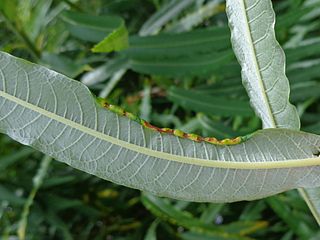
Eriophyidae is a family of more than 200 genera of mites, which live as plant parasites, commonly causing galls or other damage to the plant tissues and hence known as gall mites. About 3,600 species have been described, but this is probably less than 10% of the actual number existing in this poorly researched family. They are microscopic mites and are yellow to pinkish white to purplish in color. The mites are worm like, and have only two pairs of legs. Their primary method of population spread is by wind. They affect a wide range of plants, and several are major pest species causing substantial economic damage to crops. Some species, however, are used as biological agents to control weeds and invasive plant species.

Phytoptus avellanae is an acarine gall-mite species inducing big bud galls of up to 10 millimetres (0.39 in) across, sometimes slightly open, on the buds of hazel and on filbert. Synonyms include Phytocoptella avellanae, Eriophyes avellanae, Calycophthora avellanae, Phytoptus coryli, Phytoptus pseudogallarum, and Acarus pseudogallarum. The mites are white, about 0.3 mm long, with numerous tergites and sternites. Two forms of P. avellanae exist, a gall causer and a vagrant form that has a more complex life-cycle and does not form galls.

Aceria fraxinivora, also known as the cauliflower gall mite and the ash key gall, causes the growths, known as galls, found on the hanging seeds or "keys" of the ash (Fraxinus) species.
Aculus gemmarum is a species of mite which causes galls on the buds of willows. It was first described by Alfred Nalepa in 1892.

Aculus craspedobius is a species of mite which causes galls on the leaves of willows. It was first described by Alfred Nalepa in 1925.

Aculus magnirostris is a species of mite which causes galls on the leaves of willows. It was first described by Alfred Nalepa in 1892.

Rabdophaga marginemtorquens is a gall midge which forms galls on willows and is found in Europe. It was described by Johann Jacob Bremi-Wolf in 1847.

Aculus tetanothrix is a species of mite which causes galls on the leaves of willows. It was first described by Alfred Nalepa in 1889.

Aculus laevis is a species of mite which causes galls on the leaves of sallows. It was first described by Alfred Nalepa in 1892.
Aceria iteina is a species of mite which causes galls on the leaves of sallows and their hybrids. It was first described by Alfred Nalepa in 1925.

Phyllocoptes goniothorax is a species of mite belonging to the genus Phyllocoptes, which causes galls on the leaves of hawthorns. It was first described by Alfred Nalepa in 1889.

Acalitus brevitarsus is an eriophyid mite which induces domed, blister like swellings, known as galls, on some species of alder.

Eriophyes laevis is a gall mite which makes small, pimple-like galls on the leaves of alder. The mite was first described by the Austrian zoologist, Alfred Nalepa in 1889 and is found in Europe and North America.
Phyllocoptes malinus, also known as the apple leaf mite, is a species of mite belonging to the genus Phyllocoptes. It causes a gall, which is a swelling on the external tissues, on the leaves of apples. The mite is found in Europe and was first described by the Austrian zoologist Alfred Nalepa in 1892.
Acalitus plicans is an eriophyid mite which causes galls on beech. It is found in Europe and was first described by the Austrian zoologist Alfred Nalepa in 1917.
Acalitus stenaspis is an eriophyid mite which causes galls on beech. It is found in Europe and was first described by the Austrian zoologist Alfred Nalepa in 1891.

Aceria nervisequa is a species of mite that belongs to the family Eriophyidae. It is found in Europe and was first described by Giovanni Canestrini in 1891. The mite causes galls on the leaves of beech,

Taphrina betulina is a fungal plant pathogen that causes the gall, witches broom, which is a chemical infection of birch buds or the developing shoots, leading to a proliferation of growth. It was first described by Emil Rostrup in 1883 and is found in Europe, New Zealand and North America.

Epitrimerus trilobus is a gall mite in the family Eriophyidae, found in Europe. The mites feed on the leaves of elder (Sambucus species), causing abnormal plant growths known as galls. The mite was described by the Austrian zoologist, Alfred Nalepa in 1891.
Placochela nigripes is a gall midge which forms galls on the flower buds of elder, honeysuckle and privet. It was described by F Löw in 1877.














